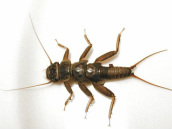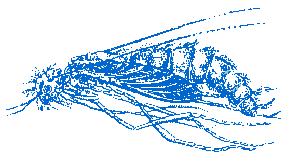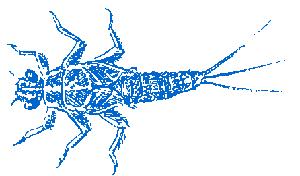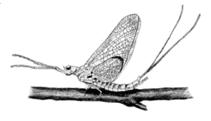Stream Entomology
Entomology is the study of insects. To pursue trout, we are primarily interested in aquatic insects.
About the (Characteristic) Keys
Keys are a way of keying in on certain characteristics of an insect. These characteristics can tell you what stage of life the insects in then the order and family the insect is from. To get to the genus and species level you will need an adult insect. While using the keys you must pay close attention to the description and not weight your final evaluation on the illustrations. With this first set of keys you should be able to get to the order of the insect you have found. We will strive to have a full set of keys identifying the families of common aquatic insects over time.
Collection of Aquatic Insects
To collect aquatic insects from streams in North Carolina requires a permit. If you ignore this regulation please be careful not to collect to frequently at the same location it may have serious effects on the ecology.
Usefull websites for identifying "bugs" includes www.cals.ncsu.edu/entomology/, www.west-fly-fishing.com then select Entomology, www.flyfishingnc.com then select Fly-Bug, www.flytying123.com then select Entomology and www.flycraftangling.com then select Entomology.
Entomology is the study of insects. To pursue trout, we are primarily interested in aquatic insects.
About the (Characteristic) Keys
Keys are a way of keying in on certain characteristics of an insect. These characteristics can tell you what stage of life the insects in then the order and family the insect is from. To get to the genus and species level you will need an adult insect. While using the keys you must pay close attention to the description and not weight your final evaluation on the illustrations. With this first set of keys you should be able to get to the order of the insect you have found. We will strive to have a full set of keys identifying the families of common aquatic insects over time.
Collection of Aquatic Insects
To collect aquatic insects from streams in North Carolina requires a permit. If you ignore this regulation please be careful not to collect to frequently at the same location it may have serious effects on the ecology.
Usefull websites for identifying "bugs" includes www.cals.ncsu.edu/entomology/, www.west-fly-fishing.com then select Entomology, www.flyfishingnc.com then select Fly-Bug, www.flytying123.com then select Entomology and www.flycraftangling.com then select Entomology.
Insect Life Stages
LARVA
The larval stage of an insect may look grub or worm like. It will have no wing pads and may or may not have jointed legs. Some larva make homes of sticks and rocks which they carry with them (cases). Go to larva stage.
PUPA
In the pupal state wings will be partially developed. The legs of a pupa maybe fused to its body or they may dangle free very close to the body. Some pupa can be found in cocoons attached to rocks on the stream bottom. Go to pupa stage.
NYMPH
In the nymphal stage the wings will be partially developed and cover by wing pads (wing case). The legs are position for crawling and the insect will be active and freely moving. Nymphs will not be found in cases or cocoons. Go to nymph stage.
ADULT
Adult insects usually have fully developed wings or have wings which are covered ba hard shell like a beetle. The adult insect will have 3 pairs of jointed legs. Go to adult stage.
LARVA
The larval stage of an insect may look grub or worm like. It will have no wing pads and may or may not have jointed legs. Some larva make homes of sticks and rocks which they carry with them (cases). Go to larva stage.
PUPA
In the pupal state wings will be partially developed. The legs of a pupa maybe fused to its body or they may dangle free very close to the body. Some pupa can be found in cocoons attached to rocks on the stream bottom. Go to pupa stage.
NYMPH
In the nymphal stage the wings will be partially developed and cover by wing pads (wing case). The legs are position for crawling and the insect will be active and freely moving. Nymphs will not be found in cases or cocoons. Go to nymph stage.
ADULT
Adult insects usually have fully developed wings or have wings which are covered ba hard shell like a beetle. The adult insect will have 3 pairs of jointed legs. Go to adult stage.
Insect Metamorphisis
“All those things I was taught in school that I didn’t need to know.”
Insects
In the next few paragraphs, we will be talking about insects, most importantly aquatic insects. First things first, what’s an insect? In the grand scheme of living things man breaks down everything into categories. Kingdom, Phylum, Class, Order, Family, Genus, Species; is any of this sounding familier yet?
In the animal kingdom under the Phylum Arthropoda there is a Class called Insecta.
In order to be in the Insecta Class the "bug" must have:
3 body parts (head, thorax, & abdomen)
3 pairs of jointed legs
1 or 2 pairs of wings
1 pair of antennae
and absolutely no legs on your abdomen
Identifying insects gets complicated because they change. Not just a little change but great big ones. Aquatic insects go from being water breathing bottom crawlers to air breathing flies. Kind of like a butterfly but the catapillar lives under water. This is called Metamorphosis, which means change. In aquatic insects there are two kinds of Metamorphosis, complete metamorphosis and incomplete metamorphosis.
“All those things I was taught in school that I didn’t need to know.”
Insects
In the next few paragraphs, we will be talking about insects, most importantly aquatic insects. First things first, what’s an insect? In the grand scheme of living things man breaks down everything into categories. Kingdom, Phylum, Class, Order, Family, Genus, Species; is any of this sounding familier yet?
In the animal kingdom under the Phylum Arthropoda there is a Class called Insecta.
In order to be in the Insecta Class the "bug" must have:
3 body parts (head, thorax, & abdomen)
3 pairs of jointed legs
1 or 2 pairs of wings
1 pair of antennae
and absolutely no legs on your abdomen
Identifying insects gets complicated because they change. Not just a little change but great big ones. Aquatic insects go from being water breathing bottom crawlers to air breathing flies. Kind of like a butterfly but the catapillar lives under water. This is called Metamorphosis, which means change. In aquatic insects there are two kinds of Metamorphosis, complete metamorphosis and incomplete metamorphosis.
|
Complete Metamorphosis
Insects that have complete metamorphosis go through four different stages. Those stages are egg, larva, pupa, and adult. The aquatic insects that go through complete metamorphosis are (listed common name first, then order): Caddisflies – Trichopter
Midges – Diptera Dobsonflies – Megaloptera Alderflies – Megaloptera Aquatic Moths – Lepidoptera Aquatic Beetles – Coleoptera Incomplete Metamorphosis
Insects that have incomplete metamorphosis go through three different stages. Those stages are egg, nymph, and adult. The aquatic insects that go through incomplete metamorphosis are (listed common name first, then order): Stoneflies – Plecoptera
Mayflies – Ephemeroptera Dragonflies – Odonata Damselflies – Odonata |
.
|
The following is detailed descriptions of each stage of metamorphosis in the life stages of insects
Larvae Stage
Larvae Stage

Caddisfly, Order: Trichoptera
Caddis larvae can be free-living or live in cases. Caddis larvae will make their cases from sticks, gravel and sand. The free-living larvae seldom have gills that are along the sides of their abdomen.

Midges, Order: Diptera
Midge larvae look like long slender maggots. The rear of their body will have either gills,
hairs, prolegs or breathing tubes. They will not have segmented legs.

Hellgrammites or Dobsonfly, Order: Megaloptera
The dobsonfly larva (hellgrammite) has many filamentous appendages on each side of his abdomen. Their back end is forked with two hooks on each tail. Hellgrammites will have six jointed legs on their thorax and large pinchers for mouth parts. Hellgramites are dark brown or black in color. The underside of the abdomen will have gill tufts. Pupa develop out of water. Can be confused with the fishfly.
The dobsonfly larva (hellgrammite) has many filamentous appendages on each side of his abdomen. Their back end is forked with two hooks on each tail. Hellgrammites will have six jointed legs on their thorax and large pinchers for mouth parts. Hellgramites are dark brown or black in color. The underside of the abdomen will have gill tufts. Pupa develop out of water. Can be confused with the fishfly.

Alderfly, Order: Megaloptera
Alderflies have a single feathery tail. The abdomen has strand like appendages extending from each side. The thorax has six jointed legs and large pinchers for mouth parts. Pupa develop out of water.

Fishfly, Order: Megaloptera
The fishfly has many filamentous appendages on each side of his abdomen. Their back end is forked with two hooks on each tail. Fishflies will have six jointed legs on their thorax and large pinchers for mouth parts. Fishflies are light in color. The underside of the abdomen is smooth with no gill tufts. Pupa develop out of water. Can be confused with the hellgrammite.

Aquatic Moth, Order: Lepidoptera
Aquatic moth larvae will usually be found on the sides of rocks covered with a silken blanket. They will have several sets of prolegs on their abdomen which when viewed through a magnifier will have tiny hooks on the end called crochets.
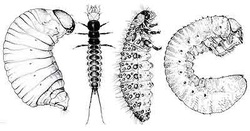
Beetle, Order: Coleoptera
Aquatic beetle larvae (second illustrations from the left) cling to aquatic vegetation and predate on eggs and other larva. Beetle larvae most often seen by anglers is the terrestrial "grub" which are the other forms in the illustration.
Pupa Stage
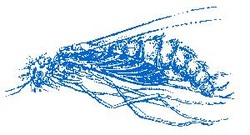
Caddisfly, Order: Trichoptera
Caddis pupa have antennae that are as long or longer than their body. The legs of the caddis
will be dangling free and not fused to their body. Caddis may also be found in cases.

Midges, Order: Diptera
Midges or true flies have short antennae on their head. Midges will have only 1 set of wing pads. The tip of the abdomen may have gills or breathing tubes.

Aquatic Moth, Order: Lepidoptera
The legs and antennae of a moth pupae will be fused to the body. The entire pupa may be found inside a silken cocoon. Two pairs of developing wings (wingpads) should be presant. A moth pupae will have no gills present.
Nymph Stage

Mayfly, Order: Ephemeroptera
Mayflies typically have plate-like gills that are located on the side of their abdomen. They will have 6 jointed legs that end in 1 claw. Most mayfly nymphs have 3 tails.

Stonefly, Order: Plecoptera
Stoneflies have no gills on their abdomen. If gills are present they will be found on the underside of the head and thorax. Stoneflies have 6 legs that end in 2 claws. Stoneflies will have 2 short tails.
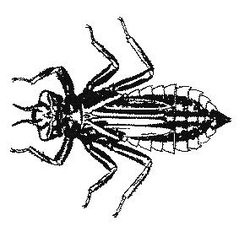
Dragonfly, Order: Odonata
Dragonflies have no tails. A dragonfly's body is squat and stout. They have large mouth parts.

Damselfly, Order: Odonata
Damselflies have 3 leaf-like tails. A damselfly 's body is long and slender.
Adult Stage

Caddisfly, Order: Trichoptera
Caddis have tent-like wings that are covered with fine hairs. They may also have very long antennae. Go to caddis larva.
 Stonefly (B. Newton, 2004)
Stonefly (B. Newton, 2004)
Stonefly, Order: Plecoptera
Stoneflies have wings that lie flat on their body when they are at rest. Stoneflies only have 2 tails which are sometimes very short.
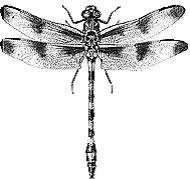
Dragonfly, Order: Odonata
A dragonfly’s abdomen is very long and slender. Its wings will lay flat out perpendicular to its sides.
.
Note: The Seth Green Trout Unlimited Chapter was gracious to allow us to use much of their entomology web pages. A majority of the illustrations you will see on these pages were drawn by Rick Harrington. He is a professional illustrator. If you wish to use the illustrations for any reason you must ask permission first. The contact information for Rick Harrington is 716-346-0772. All of the Illustrations found here are original or used with permission. The Izaak Walton League of America has graciously allowed the use their images from their Stream Study website. Their web site contains a good set of macroinvertabrate keys. Ken Manual is considered our Chapter entomologist.

